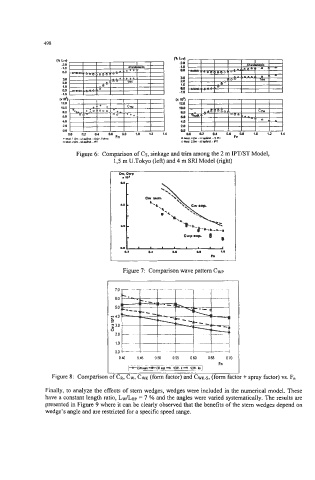Page 523 - Practical Design Ships and Floating Structures
P. 523
498
(% L”)
.2n
.in
M
30
2.0
1Jl
M
-in
10.0
8.0
6.0
4.0
2.0
0.0
M a2 a4 ” ’.‘
rYod ,.m.drrW.-W” rdw Od Fn Dd
O M PLk.5lgw .Pl
Figure 6: Comparison of CT, sinkage and trim among the 2 m IPTlST Model,
13 m U.Tokyo (left) and 4 m SIU Model (right)
or, OWP
I m*
”.‘..(
no
0.2 a4 L. a8 1.0
M
Figure 7: Comparison wave pattern Cwp
040 045 050 055 060 065 070
_. -~ Fn
[Gtiimi+Fij- ‘CW k d ‘CW 4
Figure 8: Comparison of CR, CW, CWK (form factor) and CWK-~, (form factor + spray factor) vs. F.
Finally, to analyze the effects of stem wedges, wedges were included in the numerical model. These
have a constant length ratio, Lw/Lsp = 7 % and the angles were varied systematically. The results are
presented in Figure 9 where it can be clearly observed that the benefits of the stem wedges depend on
wedge’s angle and are restricted for a specific speed range.

